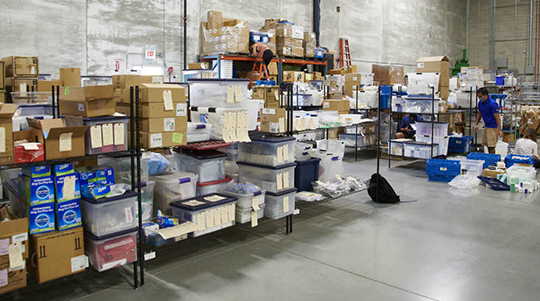7 steps to supply chain resiliency
From inventory solutions to emergency planning, systems are looking at new ways to be ready for any crisis.

Health systems today are focused on mitigating supply chain risks and implementing resiliency techniques, now more than ever before, to withstand disaster or emergency events. In the past, it was typical to find health systems handling emergency scenarios and then returning to “business as usual.” The way we operate has changed forever, and we can’t revert back to old ways. Embracing lessons learned and new techniques enables health systems to remain resilient for years to come.
In terms of solutions, several things happened during the course of the pandemic: approved substitution of products helped ensure health systems were equipped with items at all times, re-routing for transportation helped save on time, and opportunities rose to start stockpiling, which built out inventory to, at the very least, a few weeks to help ride out short term disruption. We’ve compiled a list of these solutions and more:
1. Stockpiling
Stockpiling has gained significant traction since the onset of the pandemic and is an essential way to combat supply chain disruption. Stockpiling allows for reliable access to needed supplies during an emergency. A great way to tackle issues with product shortages, it’s imperative to have a strategy in place to identify where the products will be stored.
Many health systems are maintaining a 30-60-90-day stockpile, and turning to distribution partners, like Medline, to help with inventory management, including having substitute products available when needed. Partnering with a supply chain expert that can provide square footage in warehouse space should be health systems’ first step when considering stockpiling. Having systems in place that both manage inventory and streamline operations will also help them achieve success in stockpiling and supply chain optimization.
2. 3PL
And that brings us to 3PL or third-party logistics. Many health systems will manage a stockpile on their own, but as inventory grows, so does the need for more space, more processes, and systems to manage the stockpile. In partnership with our customers, we help manage health systems’ stockpiles using Medline’s distribution center space, processes, and systems. Partnering on stockpiling management not only helps save the health system time and energy; it helps their bottom line. It can be costly to rent out public storage facilities, and oftentimes, those facilities don’t have the right conditions for storing medical supplies. Working with a distributor allows for a better facility and a more efficient overall model. Read more about our inventory management planning.
3. Substitutions
Historically, product selections have revolved around clinicians providing their list of clinically-preferred items. But what if those items are facing supply chain shortages? Understanding clinical preference versus acceptability is critical here. To buffer those challenges, having secondary preferences determined can help distributors plan inventory accordingly. In what used to be 100% or 0%, spreading the usage to other “clinically acceptable” items provide better access to alternatives when preferred products become unavailable.
It’s also important for suppliers and facilities/systems to talk about product substitutions in advance, before the possibility of a product runs out. Building a tree of product acceptability ultimately builds resiliency within the supply chain and keeps it moving, instead of enduring delays and not having access to products. At Medline, we partner to build out product substitution lists with our customers and advise on commonly used or accepted products to determine clinically acceptable options. With this approved list, it enables an option to ensure inventory is nearly always available through pre-approved auto-substitution as needed. As health systems continue to collaborate on these efforts, auto-substitution—which we have worked to develop with some of partners—will become much more prevalent in the inventory management process.
4. Collaboration
“We should all be standing on the shoulders of giants,” says Scott Wilkerson, CPO at the University of California Office of the President, UC Health.1 Unlike other industries, healthcare isn’t (or shouldn’t be) an environment of competition. It is essential to learn from and collaborate with others and look towards the future of supply chain and the industry as a whole—all in the interest of driving the best patient care.
And not only our industry—supply chain disruptions and staff shortages have affected so many industries. Sharing lessons across the board and participating in open collaboration is key to moving forward.
“As an industry, suppliers and providers — all the way from our dock to the supply room in the healthcare facility — have to be willing to look at the supply chain as a complete end-to-end solution. If we can work in unison, we can reduce duplicative efforts and create a much more streamlined approach to overall supply chain resiliency.”
—Jim Boyle
Executive Vice President at Medline
5. Transparency
Improved collaboration will also require increased transparency across all elements of the supply chain. Most believe that one of the most positive outcomes to come out of the pandemic is that it forced industries—across the board—to have increased visibility into their supply chain operations. Assuming that “things are just being taken care of” on the other end of the line just doesn’t cut it any longer. Systems need to understand how the products will be sourced and get to them on time. Distributors need to be transparent about when their customers or partners may not get what they need when they need it.
Pre-pandemic, it was less important for people to understand how a product got from point A to point B, but that has changed, and partners are working to drive more transparency. This requires more honesty and more frequent information sharing than ever before. Even if it’s bad news, your partner deserves to hear it; only then will they have the information they need to pivot if needed.
6. Supply chain optimization
Supply chain optimization (SCO) creates a leaner, more efficient supply chain. This process involves analyzing a system for gaps and customizing a unique strategy to improve supply chain across a system’s continuum of care. It often provides these benefits:
• Better visibility over your supply chain
• Inventory reduction and par optimization
• Improved labor utilization
• Superior service to clinicians
• Lower cost to serve patients and clinicians
Technology is a key driver in supply chain optimization and resiliency. It allows for enhanced visibility into inventory, potential future disruption, product substitution and transportation re-routing. The industry, as a whole, must leverage technology and utilize data and analytics. With this in mind, healthcare continues to look to other industries for more creative opportunities and ways to think outside the box—seeing how technology can be enabled to help think about supply chain design differently.
7. Emergency preparedness plans in place
Finally, reflecting on the past helps everyone learn from mistakes and consider implementing new strategic measures for emergency preparedness. Beyond that, however, the evolving needs and demands of patient care suggest that ongoing change is inevitable, and strong partnerships that value a transparent supply chain will continue to be key. At the beginning of the pandemic, Medline published an article entitled “Perspectives on the COVID-19 pandemic from healthcare associations across the continuum,” where we spoke to many leaders about disaster preparedness and other important concepts.
“When I teach incident command, I talk about the ice cream social concept: The first time you’re sitting there together with the police chief and the fire chief and the sheriff should not be in the midst of a disaster, whether it’s COVID 19, or the town is on fire or there’s been an earthquake. You should get to know each other long before that.”
—Chris Way
Director at Large, National Association of Emergency Medicine Technicians (NAEMT)
Way added that COVID-19 is a different kind of disaster that also pulls in acute and post-acute care, making all those relationships vitally important as well. It is clear that systems across the country—if they hadn’t already—have formed improved emergency preparedness plans that include many of the steps outlined in this article. For a healthy, more resilient supply chain, it will, in fact, take a collective village to make sure each and every patient receives continuous care regardless of what may come in the future.




